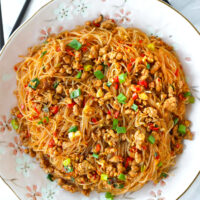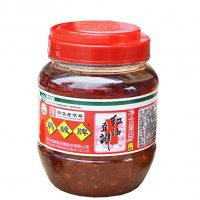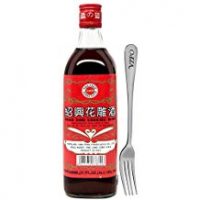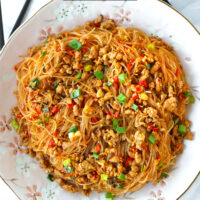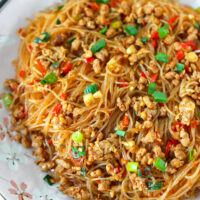 Buy Now →
Buy Now → Ants Climbing A Tree (Ma Yi Shang Shu)
Ants Climbing A Tree is a quick & easy to make Sichuan mung bean vermicelli and ground pork stir-fry with a mouthwatering spicy that’s exploding with BIG and BOLD flavors!
- Prep Time: 10
- Cook Time: 10
- Total Time: 20 minutes
- Yield: 2 1x
- Category: Dinner
- Method: Stir-fry
- Cuisine: Sichuan
Ingredients
Scale
- 120 grams / 4.2 ounces Mung Bean Vermicelli (also known as glass noodles, cellophane noodles, and bean threads) – soaked in water according to package instructions and drained
- 1.5 TBLS minced Ginger
- 5 Garlic cloves – 4 cloves minced, 1 clove grated
- 2–10 Red Chilies (Bird’s Eye preferred, but any small hot red chilies will work), to taste – chopped
- 1 Spring Onion (Scallion/Green Onion) – chopped
- 1.5 TBLS Canola Oil (or any neutral-flavored cooking oil with a high smoke point)
- ½ TSP Chili Oil (optional)
- 1.5 TBLS Dou Ban Jiang (Chili Bean Sauce) – Sichuan Pixian Dou Ban Jiang preferred, but Lee Kum Kee’s Chili Bean Sauce will work. (see notes)
- 200 grams / 7 ounces Ground Pork (or ground beef, chicken, or turkey)
- 1 TBLS Shao Xing Rice Wine
- 1.5 TBLS Low Sodium Light Soy Sauce
- ½ TSP Dark Soy Sauce
- 1 cup /237ml Hot Water (or chicken stock for more flavor)
- ¾ TSP White Sugar, to taste
- ¼ TSP Thai Chili Powder (optional), to taste – substitute with crushed red pepper chili flakes if unavailable
- To Serve: Drizzle of Sesame Oil, remainder chopped spring onion, steamed rice (optional)
Instructions
- Prep: Soak the mung bean vermicelli in a bowl filled with room temperature water as per package instructions (usually about 7-10 minutes). Once tender and pliable, drain well and set aside. Mince the ginger, 4 garlic cloves, and chop the chilies and spring onion.
- Sauté aromatics: Heat the canola oil in a large wok or deep skillet over medium heat. Once hot, add the dou ban jiang and ginger and sauté for 10 seconds. Then add the minced garlic and red chilies and stir-fry for 30 seconds to combine.
- Cook the pork: Add the ground pork and cook for 2 minutes, breaking up the lumps with your spatula, until almost cooked through.
- Add the sauces: Add the Shao Xing rice wine, low sodium light soy sauce, and dark soy sauce. Toss for 30 seconds to combine, or until the pork has cooked through.
- Stir in water and seasonings: Pour in the hot water, and stir in the white sugar and Thai chili powder (if using). Simmer for about a minute to let the flavors meld.
- Add the noodles: Add the mung bean vermicelli and use tongs and a spatula to toss for 2-3 minutes, or until the noodles have absorbed almost all of the sauce.
- Toss through garlic and spring onion: Grate the remaining garlic clove directly on top the noodles and add most of the spring onion (reserve some for garnish). Toss for 30 seconds to combine, then switch off the heat.
- To Serve: Divide evenly onto plates, and drizzle a bit of sesame oil on top. Garnish with the remainder spring onion and serve immediately either on its own, or with steamed rice.
Notes
Ingredient Notes, Cook’s Tips, and FAQs
- Noodles and sauces: Mung bean vermicelli, Shao Xing rice wine, and dark soy sauce can all be found in an Asian or Chinese supermarket, or online. You can substitute dry sherry for the Shao Xing rice wine and low sodium light soy sauce for the dark soy sauce if unavailable.
- Dou ban jiang: I used a Pixian dou ban jiang, which is more authentic and stronger in flavor than the Cantonese type of dou ban jian made by Lee Kum Kee. Outside Asia, the best way to get your hands on Pixian dou ban jiang would be to order it online. However, if can only find (or already have) Lee Kum Kee’s version of the sauce on hand, feel free to use it instead as it’ll still be tasty.
- Chilies and chili oil: Adjust the number of chilies you use to suit your preference. Or omit them, the chili oil, and the Thai chili powder to make this dish milder.
- For more saucy noodles: Add a little more hot water in step 5 than indicated, and don’t wait for the noodles to absorb almost all of the sauce in step 6. You can proceed with the final steps and then serve. Depending on how much more water you add, you may need to increase the amount of dou ban jiang and seasoning sauces as per your taste.
- Can I make this ahead? I don’t recommend making this dish ahead as the noodles will continue to absorb the sauce once off the heat. They may become too dry by the time you’re ready to eat. It’s best eaten immediately, or at least within the same hour after cooking.
- See post above for variations if you’d like to customize this dish.
Nutrition
- Serving Size: 1 plate
- Calories: 694
- Sugar: 9.1g
- Sodium: 1180.4mg
- Fat: 35.8g
- Saturated Fat: 9.3g
- Unsaturated Fat: 22.2g
- Trans Fat: 0g
- Carbohydrates: 69.4g
- Fiber: 3.4g
- Protein: 20.8g
- Cholesterol: 72mg
Find it online: https://thatspicychick.com/ants-climbing-a-tree/
